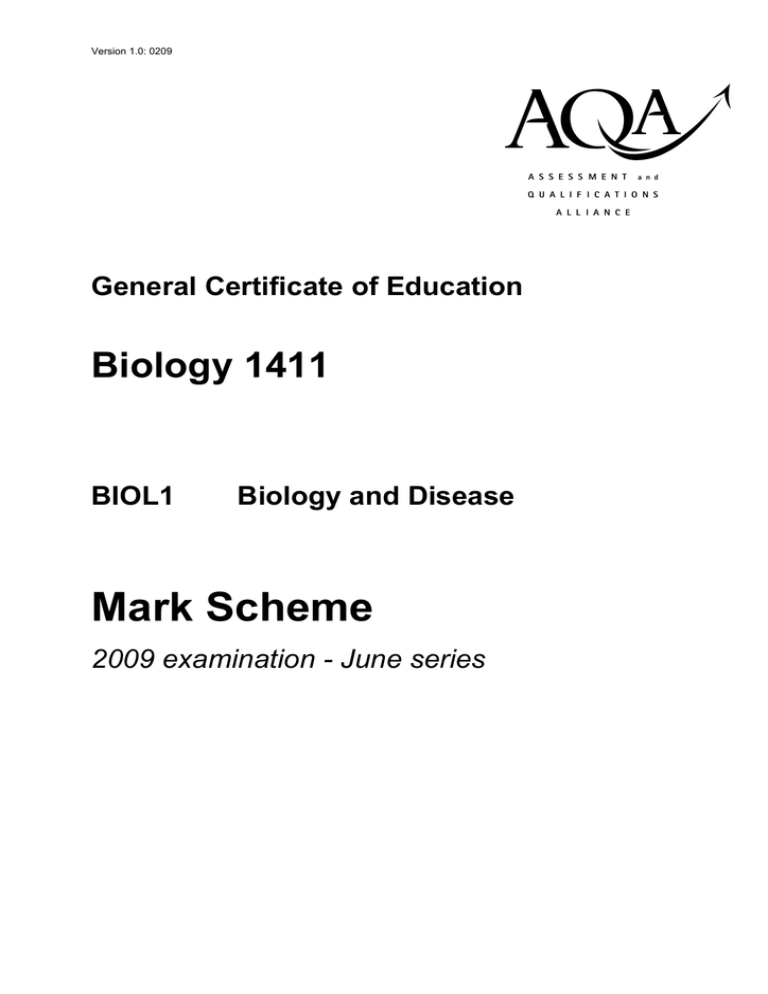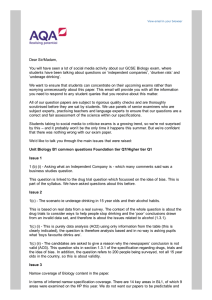
Version 1.0: 0209
abc
General Certificate of Education
Biology 1411
BIOL1
Biology and Disease
Mark Scheme
2009 examination - June series
Mark schemes are prepared by the Principal Examiner and considered, together with the
relevant questions, by a panel of subject teachers. This mark scheme includes any
amendments made at the standardisation meeting attended by all examiners and is the scheme
which was used by them in this examination. The standardisation meeting ensures that the
mark scheme covers the candidates’ responses to questions and that every examiner
understands and applies it in the same correct way. As preparation for the standardisation
meeting each examiner analyses a number of candidates’ scripts: alternative answers not
already covered by the mark scheme are discussed at the meeting and legislated for. If, after
this meeting, examiners encounter unusual answers which have not been discussed at the
meeting they are required to refer these to the Principal Examiner.
It must be stressed that a mark scheme is a working document, in many cases further
developed and expanded on the basis of candidates’ reactions to a particular paper.
Assumptions about future mark schemes on the basis of one year’s document should be
avoided; whilst the guiding principles of assessment remain constant, details will change,
depending on the content of a particular examination paper.
Further copies of this Mark Scheme are available to download from the AQA Website: www.aqa.org.uk
Copyright © 2009 AQA and its licensors. All rights reserved.
COPYRIGHT
AQA retains the copyright on all its publications. However, registered centres for AQA are permitted to copy material
from this booklet for their own internal use, with the following important exception: AQA cannot give permission to
centres to photocopy any material that is acknowledged to a third party even for internal use within the centre.
Set and published by the Assessment and Qualifications Alliance.
The Assessment and Qualifications Alliance (AQA) is a company limited by guarantee registered in England and Wales (company number 3644723) and a registered charity (registered charity number 1073334).
Registered address: AQA, Devas Street, Manchester M15 6EX
Dr Michael Cresswell Director General
Biology - AQA GCE Mark Scheme 2009 June series
Question
Part
Sub Part
Marking Guidance
Mark
1
(a)
(i)
Crista/inner membrane;
1
1
(a)
(ii)
Matrix;
1
1
(b)
B;
1
1
(c)
(i)
Reduce/prevent enzyme activity;
1
1
(c)
(ii)
Prevents osmosis / no (net) movement of water;
2
Comments
Q Allow reference to cell rather than
organelle for first mark point only.
So organelle/named organelle does not burst/shrivel;
Regard damage as neutral
1
(d)
(Mitochondria) use aerobic respiration;
2 max
Mitochondria produce ATP/release energy;
Energy/ATP required for muscles (to contract);
3
Q Do not accept reference to
making/producing energy.
Biology - AQA GCE Mark Scheme 2009 June series
Question
Part
2
(a)
Sub Part
Marking Guidance
Mark
Comments
Sends out electrical activity/ impulses;
2
Q Ignore reference to ventricles.
Initiates the heartbeat / acts as a pacemaker / (stimulates)
contraction of atria;
2
(b)
Fluctuation and overall decrease;
2
Steep decrease first/after two years and then gradual
decrease;
2
(c)
Diet low in cholesterol/LDLs;
2
Less absorbed into blood/ from intestines;
2
(d)
Diet has greater effect in decreasing blood cholesterol
concentration;
Difficult to judge effect of drug as it is used at same time as
diet / drug is not used on its own;
Decrease in blood cholesterol concentration linked to reduced
risk of heart disease;
4
2 max
Q Allow converse for third marking
point.
Biology - AQA GCE Mark Scheme 2009 June series
Question
Part
3
(a)
Sub Part
Marking Guidance
Mark
Comments
Enzyme/active site has a (specific) tertiary structure;
3 max
Q Allow second mark if candidate
refers to correct shape or
complementary in terms of the
enzyme. Do not allow ‘same’ shape
Only glucose has correct shape / is complementary / will
bind/fit;
To active site;
Q Do not allow third mark if active
site is described as being on
substrate.
(Forming) enzyme-substrate complex;
3
(b)
(Only detects glucose whereas) Benedict’s detects (all)
reducing sugars/named examples;
2 max
Provides a reading / is quantitative / Benedict’s only provides
a colour / doesn’t measure concentration / is qualitative/semiquantitative;
Q Allow Benedict’s detects
monosaccharides for first mark
point.
Is more sensitive / detects low concentration;
Red colour/colour of blood masks result;
Can monitor blood glucose concentration continuously;
3
(c)
(i)
Broken down by enzymes / digested / denatured (by pH) too
large to be absorbed;
1
3
(c)
(ii)
Study not carried out on humans / only carried out on rats;
2 max
Long-term/side effects not known;
Scientists have vested interest;
Study should be repeated / further studies / sample size not
known;
5
Q Do not credit quicker/more
accurate unless qualified.
Biology - AQA GCE Mark Scheme 2009 June series
Question
Part
4
(a)
Sub Part
Marking Guidance
Mark
Damage/destruction of cells/tissues;
2
Comments
Production of toxins;
4
(b)
Contains antigen/proteins / dead/weakened
microorganism/pathogen/virus/bacteria;
2
Q Do not credit immune response
unless qualified.
2 max
Q Do not credit sample size.
Stimulates production of antibodies/plasma cells/memory
cells;
4
(c)
(i)
Age;
Sex;
Q Allow any suitable reference to
health not being affected for fourth
marking point e.g. smoking,
‘depressed immune system’ etc.
Ethinicity;
All healthy / not on other medication;
Not previously vaccinated/infected with TB;
4
(c)
(ii)
Contain the same antigens;
1
6
Biology - AQA GCE Mark Scheme 2009 June series
Question
Part
5
Sub Part
Marking Guidance
Mark
(a)
Nucleus;
1
5
(b)
Enables organism to remain in area (of food source) / prevent
its removal;
1
Q ‘To attach’ is not sufficient unless
qualified;
5
(c)
Correct answer of 222(%);;
2
Correct answer gains two marks
1
Q Allow any reference to growth or
replication of ‘organisms’. Do not
penalise reference to bacteria.
(i)
Comments
Incorrect answer that clearly identifies difference in number of
cases as 5800 –1800 or 5.8 – 1.8;
5
(c)
(ii)
More water-related activities / more ‘organisms’ with
increased temperature;
Q Do not allow increase in water
consumption.
5
(d)
(i)
All have same shape / only binds to Giardia/one type
of/specific antigen;
1
5
(d)
(ii)
Has complementary (shape) / due to (specific) tertiary
structure / variable region (of antibody);
1
5
(d)
(iii)
Enzyme/second antibody would remain / is removed by
washing;
2
Enzyme can react with substrate (when no antigen is present);
7
Q Binds/fits not sufficient unless
qualified;
Biology - AQA GCE Mark Scheme 2009 June series
Question
Part
6
(a)
Sub Part
Marking Guidance
Mark
Comments
Phagocytes engulf/ingest
pathogens/microorganisms/bacteria/viruses;
2 max
Q Allow description of process of
engulfing;
Phagocytes destroy
pathogens/microorganisms/bacteria/viruses;
Lung diseases are caused by
pathogens/microorganisms/bacteria/viruses;
6
(b)
(i)
Alveoli/lungs will not inflate/deflate fully/reduced lung capacity;
2 max
Breathing out particularly affected/no longer passive;
Concentration/diffusion gradient / rate of diffusion reduced;
6
(b)
(ii)
Alveolar walls thicken;
4
Longer diffusion pathway;
Scarred/fibrous tissue;
Reduces surface area (for gaseous exchange);
6
(c)
(i)
Cancer develops 20 – 30 years after exposure (to asbestos);
1
6
(c)
(ii)
Smoking / air pollution / specified industrial source;
1
8
Q Diffusion is essential for 2nd point
and surface area for 4th point.
Biology - AQA GCE Mark Scheme 2009 June series
Question
Part
7
(a)
Sub Part
Marking Guidance
Mark
Comments
Amylase;
5 max
Q Do not penalise incorrect site for
digestion or incorrect site of enzyme
production.
5 max
Q Only allow diffusion mark in
context of movement of glucose into
the blood.
(Starch) to maltose:
Maltase;
Maltose to glucose;
Hydrolysis;
(Of) glycosidic bond;
7
(b)
Glucose moves in with sodium (into epithelial cell);
Via (carrier/channel) protein/symport;
Sodium removed (from epithelial cell) by active
transport/sodium-potassium pump;
Into blood;
Maintaining low concentration of sodium (in epithelial cell) /
maintaining sodium concentration gradient (between lumen
and epithelial cell);
Glucose moves into blood;
By (facilitated) diffusion;
9

